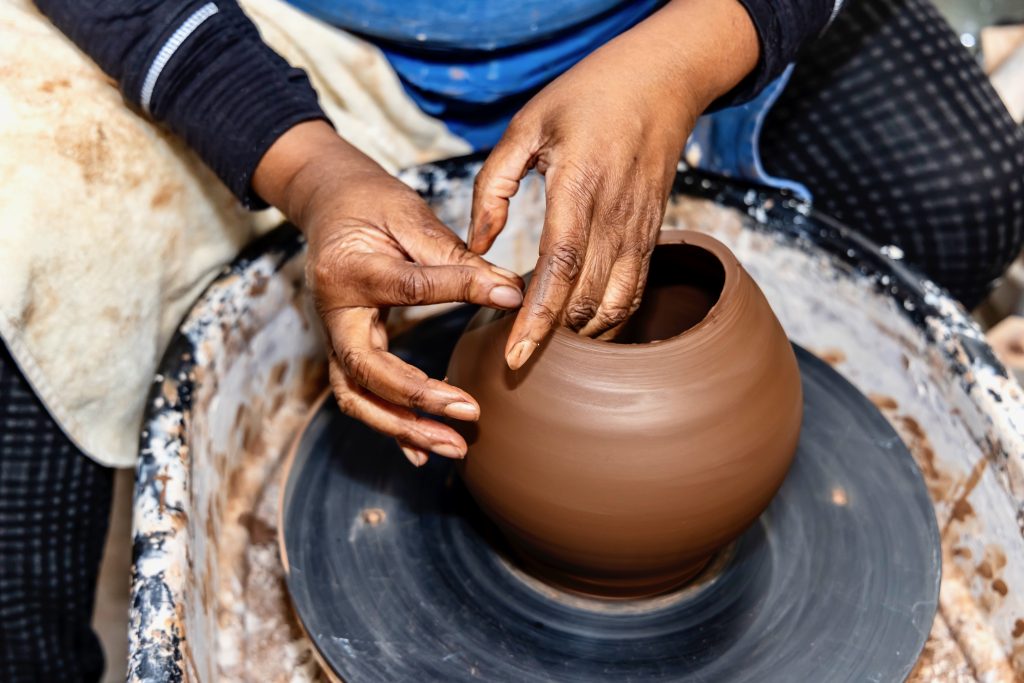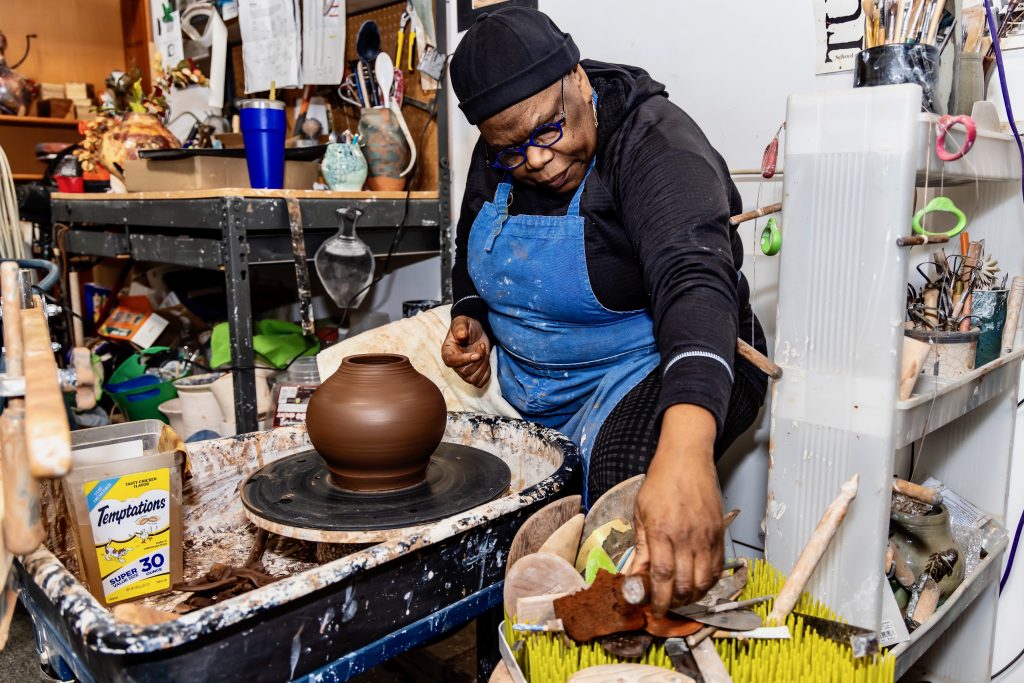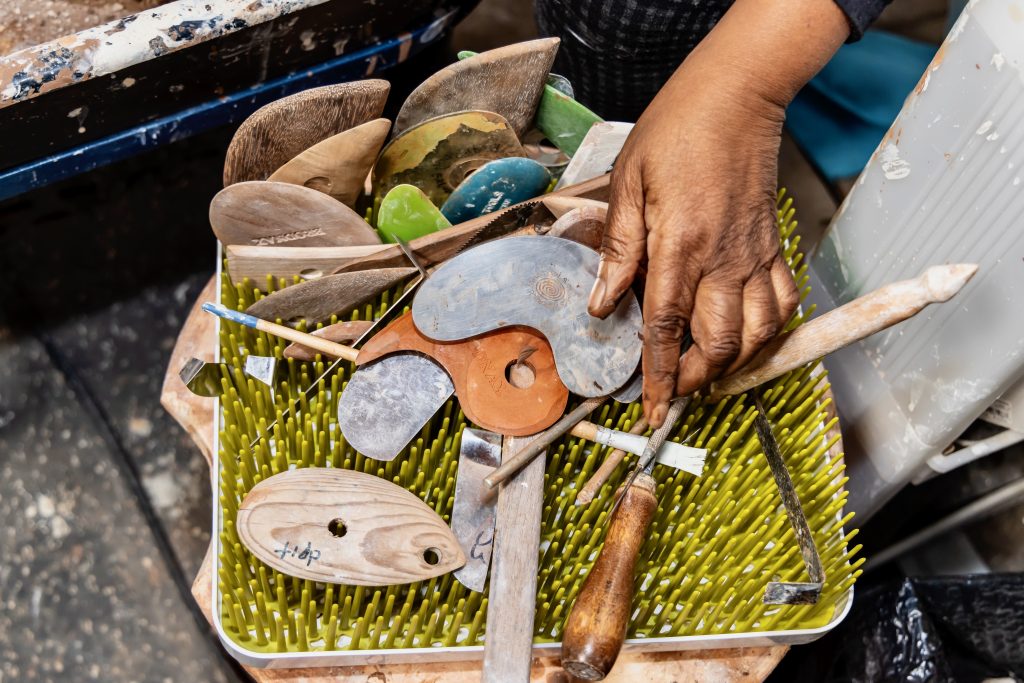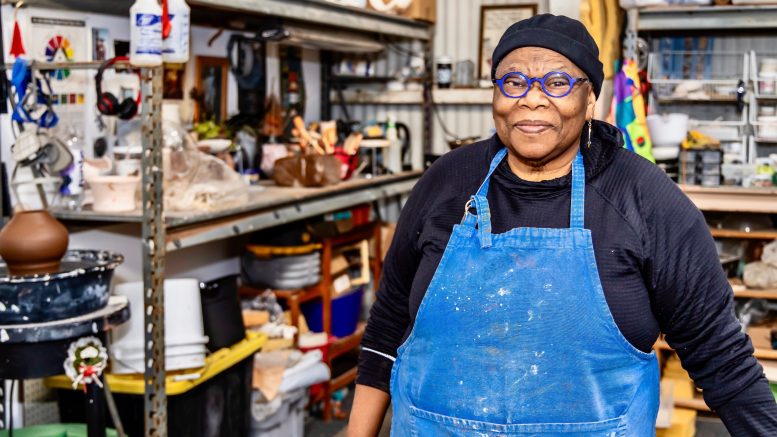By Joan Cusick
Brooklyn-born Deborah Pittman devoted decades of her life to the clarinet, playing on Broadway and for the symphony orchestra in Sacramento. But that turned out to be merely an overture for a lifetime exploring the arts.
Pittman moved from New York to Sacramento in 1981, but after nine years with the symphony, she “decided it was killing my soul, it was killing my body, and I should take a leave of absence to find out if I wanted to continue.”
The classical clarinetist turned from performing to teaching — first at UC Davis, then at Sacramento State. At UC Davis, she led the Capital Arts Project, which brought together a teaching team of professional artists with art teachers of every level.
“When I put on my first institute for those teachers in the summer, our artist was Sam Tubiolo,” Pittman says. “He did an activity one evening with the entire workshop. I went home that night and I did not want to go back to UC Davis the next day. I wanted to find a clay class as soon as possible. … I was taken quickly, swiftly with passion for ceramic art.”
But Pittman’s artistic journey didn’t end at the pottery wheel. The multifaceted artist now balances ceramics, music, writing and filmmaking, including a recent film about her father called “The World According to Earl.”
“Do I love one more than the other? On some days,” she says about her various artistic endeavors. “On some days when I’m playing something really exciting, I get that feeling for the clarinet again.”

I think of different pursuits like having children — I can’t love one more than the other. Do you love one more than the other?
I probably don’t love the clarinet as much as I used to. I have been playing the clarinet for 61 years. But when I discovered pottery, some of the things that appealed to me were no wrong notes, no playing out of tune. When you’re classically trained on the clarinet, you really have to do it the way your teacher did it — the way his teacher did it all the way back to the first clarinetist that inspired Mozart — but I immediately felt like I didn’t need to do that in pottery. That was incredibly freeing for me.
I was always trying to push the envelope, trying to do things differently. When we learned some new shape or form, I wanted mine to be distinguished in some way. I did not want to open the kiln to see 11 pieces that looked the same.
It’s been a long journey from that initial throwing class because I don’t like people to buy my pots and put flowers in them, I think they are art already. To make sure they don’t do that, I tend to cut open my pots. They can’t put water in it.
How long does it normally take you to make a pot?
On the days that I come in — I like to try to be here four days a week, three hours a day — I can throw one pot a day, and then I spend time sort of doing the next steps on another pot that’s not super wet. In the winter, a pot takes a long time to dry. So I wind up with a lot of pieces that are drying, and getting ready to go into the kiln for the first firing.
The first firing is interesting in that it might take somewhere between 6 and 9 hours for that pot to get up to temperature and fire. But then it takes about 10 hours for the kiln to cool down enough that you can take it out and touch it. Ideally, you should not open the kiln [when it’s] higher than 200 degrees. When it gets down to 200, you can take it out and/or at least open it and start to cool things in there.
So it’s a long process, and most of the time that I make things, I have a certain finishing technique or certain cuts that I have in mind. It’s kind of interesting because I don’t have a lot of cut pots on the wall right now. But I made a couple of pots before I decided to stop and give my shoulder a break back in the spring. I did not really have time or energy to cut them, so it’s all about surface treatment.
Do you see your artistic expression changing in the next five years?
I do imagine that I will evolve as I get more and more confident with it, because there’s a certain point in this pot’s life where it’s the right dryness to cut it, and if you miss that, forget it, you can’t cut it. And that kind of is a challenge over the time that you’re cutting the whole design, because you’ve got to keep it mostly in a plastic bag and work on a little section, but you want to see a bigger section so that you’re doing something that’s kind of balanced. I think I’ll get better and better at that. But right now, there’s nothing that I’m wanting to integrate into my style or my design.

You’ve expanded into writing and filmmaking. Do those disciplines give you the same freedom that pottery does?
Absolutely. I never started out wanting to be a filmmaker. At the time, I was playing with a trio — a very eclectic trio. I played clarinet and Native American flutes, Maki [Kuper] plays traditional orchestral flute, and Omari was a baritone singer.
Omari [Tau] was tired of playing traditional concerts, so we decided we were going to do some big kind of project. And we decided to create a documentary on historical Oak Park. We created this three-part documentary series and three-part concert series that accompanied each film. And that was a big awakening because most of the time when I do stuff, I mean, aside from classical music, I’m really like the boss of what and how I do it. And, you know, finding out that I didn’t know enough about film to really have a big opinion, it was interesting.
After that, another colleague and I created a short film on Chevalier de Saint-George — the guy they used to call the Black Mozart. I wrote the script for it and the producer said to me, “Would you like to co-produce this?” And I was like, “No, I have so much on my plate.” And she said, “But you know, co-producing is the way to make sure that not one word that you’ve written for the script will change.” So I said yes.
That was an enormous project and we decided that we were going to give it away for free to any teachers or Girl Scout leaders or community people who wanted to show that film.
What’s your primary focus?
I just finished a film about my dad, which is called “The World According to Earl.”
Once I moved out here, my dad and I used to have a conversation every Sunday. After a while, I start[ed] to write things down that he said. I asked him, “Dad, do you mind if I share this?” And he said to me, “Take it to the people, they need to know.”
My dad was quite a character. He had a third-grade education, and he was like one of the smartest people I knew. He had amazing math skills, and I was good in math growing up, and I used to see him … I was like, “Isn’t that my dad over there talking to my math teacher?” They were always trying to steer me into that direction. My dad hated with a passion the clarinet. He hated that I played it. But my dad had this big investment in education, not only for my sister and myself, but he talked to kids in the project … My dad was 6-foot-5 with arms like Popeye. These kids listened to him.
I got an NEA [National Endowment for the Arts] grant to make this film, which was a big surprise to me. And so I’ve been applying to film festivals; we’ve gotten some accolades from different film festivals.

If you could change one thing, what would it be?
If I could change one thing, it really would be that every soul on this planet got to participate in some kind of art on a daily basis. I think the arts really heal.
I started playing clarinet when I was 10, in seventh grade. As a really painfully shy person, one day my clarinet teacher said to me — he was always giving me grief about not playing loudly enough — he was like, “Do you want to play for yourself or you want to play for people?”
“I want to play for people.”
He was like, “OK, put your clarinet down, I’m going to tell you something. Your playing is never gonna change until your personality changes.”
So on the subway going home, I was trying to unpack that and I thought, “Either that’s a huge insult, or he’s trying to tell me that, oh, I need to act confident. OK.” Pretty much my personality changed that day. It wasn’t really my personality yet, but I could act.
And so I think of the changes playing the clarinet started to make in my life, in terms of having somewhere to go — my bedroom — and something to do that my parents could hear. I was always a child that spent a lot of time in my bedroom. I’d either be reading, or what I call hiding. I don’t know why, but as soon as they would hear me playing the clarinet, they’d think, “OK, she’s OK.”
Let me tell you, you grow up in New York and you get to the point where you’re taking an average of one or two auditions a month. Your personality changes. … So that would be my wish for the world — arts, and lots of it.
Deborah Pittman’s ceramics studio at E Street Gallery and Studios, 1115 E St., will be open from 10 a.m. to 5 p.m. Sept. 14-15 as part of the Sacramento Open Studio Tour. Her ceramics will be sold Nov. 29-Dec. 1 during the Crocker Holiday Artisan Market at Scottish Rite Center, 6151 H St. Pittman will perform on clarinet at 3 p.m. Sept. 22 with ClariSonix, Sacramento’s Premiere Clarinet Quartet, at Campus Commons Clubhouse. She will also perform as a soloist with Symphony d’Oro at 4 p.m. Nov. 2 at Koreana Plaza and at 4 p.m. Nov. 3 at Cordova High School Performing Arts Center, both in Rancho Cordova. For more information, visit her website at www.deborahpittman.com
For the complete Deborah Pittman interview and photo essay by photographer Joan Cusick, visit https://www.joancusick.com/70/Deborah-Pittman
This story was funded by the City of Sacramento’s Arts and Creative Economy Journalism Grant to Solving Sacramento. Following our journalism code of ethics and protocols, the city had no editorial influence over this story and no city official reviewed this story before it was published. Our partners include California Groundbreakers, Capital Public Radio, Outword, Russian America Media, Sacramento Business Journal, Sacramento News & Review, Sacramento Observer and Univision 19.



Be the first to comment on "Lifetime in the arts: Deborah Pittman’s journey from clarinet to clay"